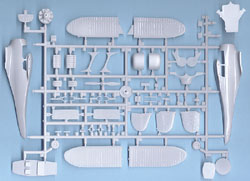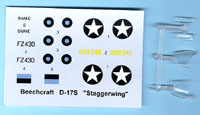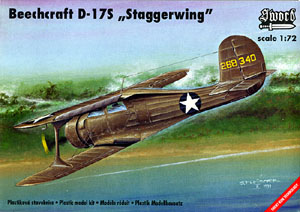Sword’s 1/72 Beechcraft
D-17S “Staggerwing” By Jim Schubert | | It's going to be tough keeping this in-the-box review as short as our editor wants as the "Staggerwing" is one of my four most favorite airplanes. The fact this is a good kit makes the task no easier. History The "back-stagger" or "negative stagger" of the wings on this family of biplanes makes them instantly identifiable as Beech model 17s. There was no Beech model 16 or any earlier model number. In 1929 Walter H. Beech sold his Wichita based Travel Air Company to Curtiss-Wright and when he bought it back later that same year, after the stock market crash, for a fraction of what he sold it for, and gave it his own name, he continued the Travel Air model number series. The "Twin-Beech", which followed the Staggerwing, was Model 18. The prefix letter to a Beech model number indicates its sequence within the series and the suffix indicates the engine used. The "S" suffix in our case signifying the Pratt & Whitney R-985. Wright and Jacobs engines were also used on the Model 17. The largest engine used, the 700HP Wright R-1300 gave the A-17F a top speed of 250 MPH despite fixed landing gear! The smallest engine, the 225 HP Jacobs L-4 gave the B-17L and C-17L a top speed of only 175 MPH. These two models are desirable today as "Poor-Mens' " Staggerwings; "poor" being relative. The D-17S with its 420 HP cruised just under 200 and topped out at 212 MPH; these were the Lear-Jets of their day. The D-17, designed shortly before WWII, was built in the greatest number of any Beech until the post-war Model 35 Bonanzas. Most of the D-17Ss went to the US Government; 207 as UC-17s/UC-43s for the Army and 342 as GB-1s/GB-2s for the Navy. 150 of the Navy's lot went to the UK under Lend-Lease being called "Travellers". Before the end of WWII Beech modified a company owned D-17S as the prototype of the ultimate Staggerwing, the G-17S, intended to keep the factory busy until the vee-tailed Bonanza got going. Components for 20 G-17Ss were made in 1946/7, but the airplanes were not assembled until they were sold; the last in 1950.  The Kit The Kit
Sword’s D-17S is in the flimsy end-opening box typical of Czech kits. This is one of my main complaints. Another is that, although the kit is labeled as a D-17S, the box art and the decal markings are for a UC-43 and a GB-1. I would prefer a couple of colorful civilian airplanes. Everything else is pretty good. The history, instructions and two color schemes are on both sides of an A-4 sheet and are adequate; there is no parts map. Staggerwings all had one doubled set of flying and landing wires on each side; the instructions do not address rigging. The 56 gray plastic parts are all one sprue tree and are pretty will molded with fairly sharp detail. The clear parts comprise the windscreen and the two side windows.  Close kit examination reveals: The concavity in the underside of the lower wing center section is too shallow. The chord of the rudder is too narrow. Both main wheels, on the review sample, have large sink marks on both sides (once more into the spares box). The stringers on the belly are denoted by scribed lines! The prominent elevator mass balances are not included (visit a Bf.109E kit for these). The propeller is heavy and is well replaced with Aeroclub p/n P007; an 8'6" Hamilton-Standard controllable pitch unit. Close kit examination reveals: The concavity in the underside of the lower wing center section is too shallow. The chord of the rudder is too narrow. Both main wheels, on the review sample, have large sink marks on both sides (once more into the spares box). The stringers on the belly are denoted by scribed lines! The prominent elevator mass balances are not included (visit a Bf.109E kit for these). The propeller is heavy and is well replaced with Aeroclub p/n P007; an 8'6" Hamilton-Standard controllable pitch unit.
With the wheels down the Staggerwing's wheel well is a vast cavern full of steel tubes and the main body fuel tank. The kit provides nothing in this area; how you address it I leave to you. I'm still figuring it out for my 48th scale G-17S. Conclusion Of extant 72nd scale Staggerwing kits, all D-17Ss, this is the best. Meikraft's is the worst and unbuildable; Rareplanes' vac kit is accurate and buildable. AMT's 48th scale G-17S is good but the fuselage is a scale 12 inches too long! I've corrected this, but 'twarnt easy. A poor 32nd scale D-17S was offered about 30 years ago, but I can't remember who issued it. If you want a 72nd scale Staggerwing, the Sword kit's for you. Kudos to Sword. Now, Messrs. Sword, how about a really good de Havilland DH-88 Comet racer to replace Airfix and Frog's horrors? References -
Staggerwing: Robert T. Smith, Maney Press. (I don't have the book to hand, so I can't give the rest of the info on date and ISBN. THE definitive work on the subject.) -
Air Progress: June/July 1964 (Drawings by James Triggs of the series A/G.) -
The Best Of Wylam - Model Airplane News: (Don't know the date of issue. Good detail on the series A/G. -
Aeromodeller: October 1963 (article and drawings by G.A.G. Cox) -
IPMS/USA Modelers' Journal: Vol. 5, #2 Jan. 1993. (Fred Horky article converting AMT's G-17S to a D-17S. Drawings and techniques. Reverse the process to convert Sword's kit to a G-17S.) | 









    |

 The Kit
The Kit Close kit examination reveals: The concavity in the underside of the lower wing center section is too shallow. The chord of the rudder is too narrow. Both main wheels, on the review sample, have large sink marks on both sides (once more into the spares box). The stringers on the belly are denoted by scribed lines! The prominent elevator mass balances are not included (visit a Bf.109E kit for these). The propeller is heavy and is well replaced with Aeroclub p/n P007; an 8'6" Hamilton-Standard controllable pitch unit.
Close kit examination reveals: The concavity in the underside of the lower wing center section is too shallow. The chord of the rudder is too narrow. Both main wheels, on the review sample, have large sink marks on both sides (once more into the spares box). The stringers on the belly are denoted by scribed lines! The prominent elevator mass balances are not included (visit a Bf.109E kit for these). The propeller is heavy and is well replaced with Aeroclub p/n P007; an 8'6" Hamilton-Standard controllable pitch unit.







